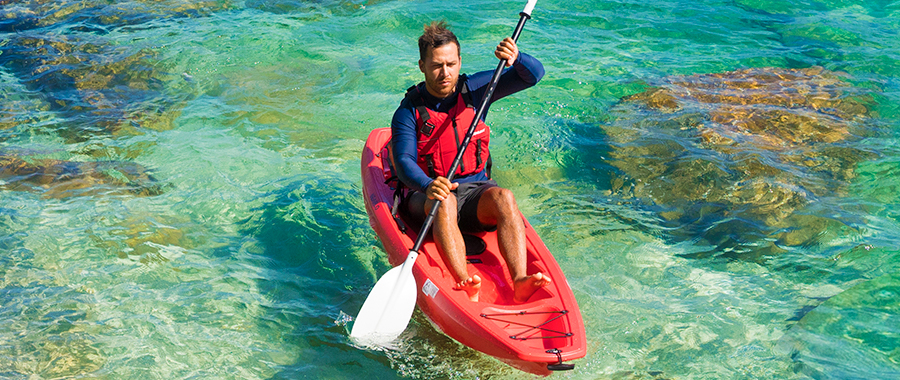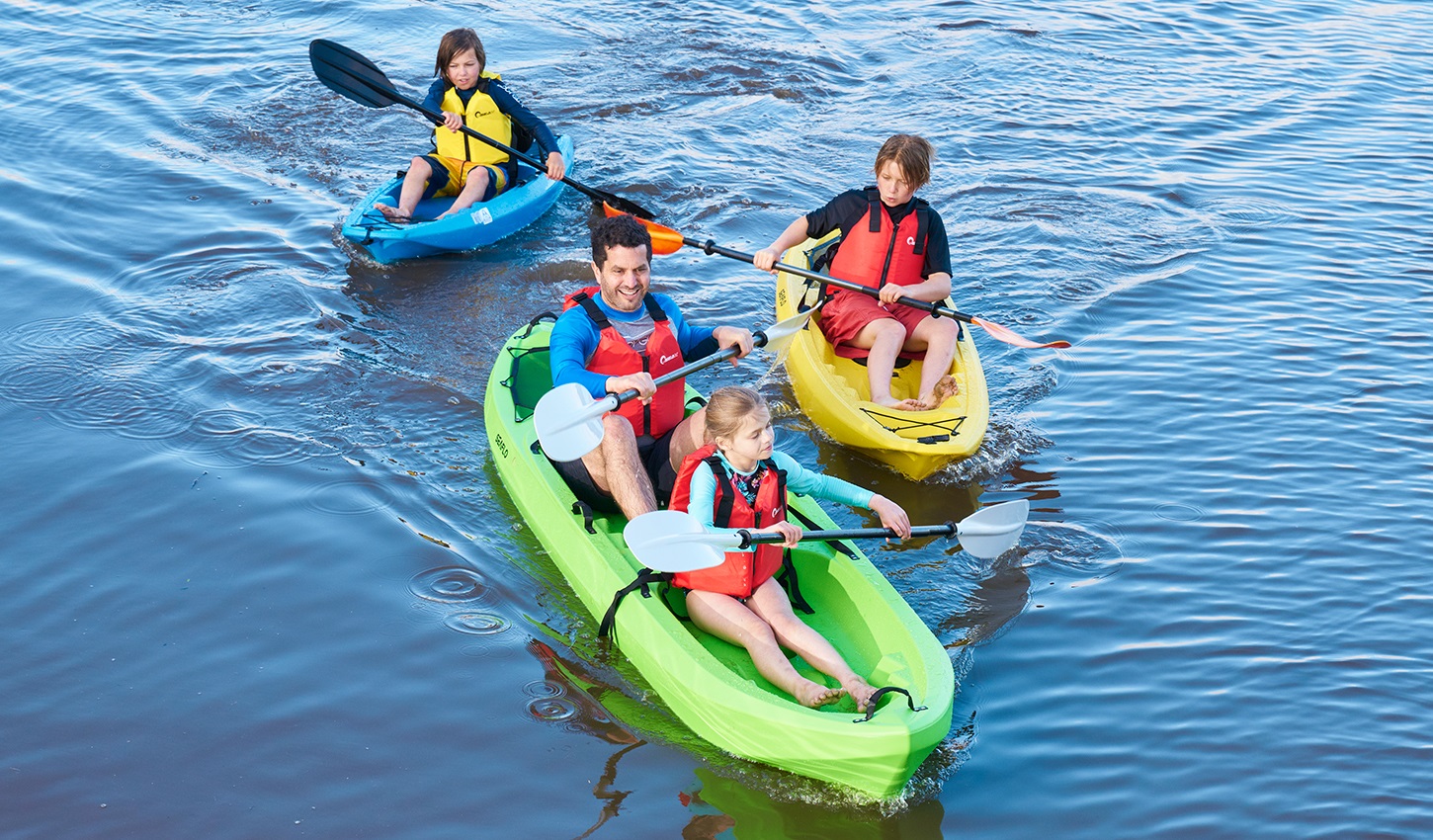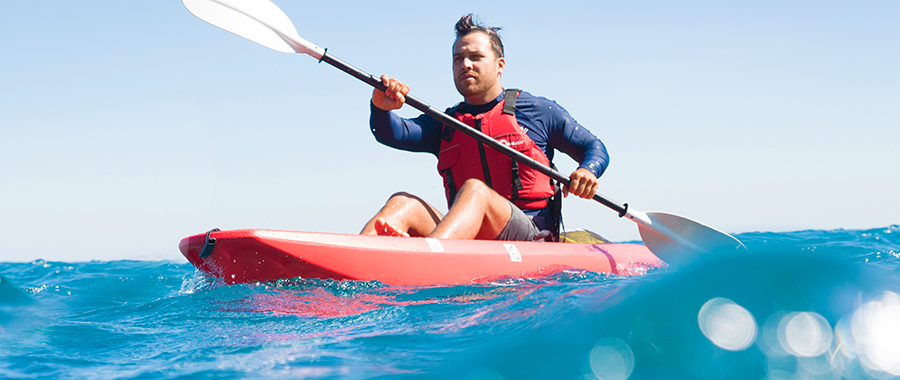| Your browser is not supported. | ||
|
Please browse our site using any of the following options:
| ||
How To Get Into Kayaking

As well as offering an opportunity to see nature from another perspective, kayaking is a fun way to stay fit and enjoy summer on the water. Like a number of outdoor activities, it might look a little intimidating and equipment-heavy at first but it's much easier to master than you may think. Additionally, kayaking is an accessible water sport, regardless of the size of your car or whether you're doing it solo. Here are some of the best pointers when it comes to how to get into kayaking.
Quick Links
- What Is Kayaking?
- How To Start Kayaking
- Different Types Of Kayaks
- Choosing The Right Paddle
- Getting Your Kayak To & From The Water
- What Kayak Accessories Do You Need?
- What Are The Benefits Of Kayaking?
What Is Kayaking?
Kayaking is a water sport where individuals paddle small, narrow boats known as kayaks. Seated in a slender vessel, paddlers navigate rivers, lakes and oceans, propelled by their own strength and agility. From serene flatwater to adrenaline-pumping whitewater rapids, each paddle stroke is a dance with the currents, a testament to the kayaker's prowess. With roots in Arctic hunting, kayaking has evolved into a recreational and competitive pursuit. Participants use double-bladed paddles to propel themselves through the water, employing a combination of strokes for steering and speed. A symphony of balance, technique and finesse, kayaking demands mastery of strokes and a deep connection with the water. It offers a unique perspective of the natural world, immersing enthusiasts in stunning landscapes and wildlife habitats. Whether seeking tranquillity or adrenaline, kayaking provides a thrilling and rewarding experience, blending physical exertion with a deep appreciation for the outdoors.
How To Start Kayaking
When it comes to buying a kayak and kayaking equipment, it pays to do a bit of research before loosening the purse strings. As with just about anything for the outdoors, understanding what's going to suit you or your family members will ensure you don't overspend or short-change yourself on potential fun. Ask yourself some simple questions:
- Who will be using the kayak? Will it be just adults using the kayak? Or both adults and kids? Are these kayakers pure beginners? Or people with some paddling experience? Are they fit? Or people who aren't usually active in their everyday lives?
- How often will it be used? Do you intend on getting year-round use from your kayak? Or will it be used predominantly in the warmer months?
- Where will you be using your kayak? Will you be taking it to the beach? Or heading to a lake or a river?
- How will you transport it? Will you need to buy roof racks for the car? Or a trolley to get it from one place to another?
Having an idea of your responses to these questions will ultimately make your kayaking choice easier and ensure you're purchasing the right product for your needs at the price that fits your budget.

Different Types Of Kayaks
Kayaks come in two basic designs which are sit-on-top and sit-in kayaks. Here's how they differ:
Sit-On-Top Kayaks
Sit-on-top kayaks are perfect for beginners and kids. They are also increasing in popularity among anglers, with many fishing-specific models now available. With sit-on models, the rider literally sits on top of the boat, allowing water to splash onto the deck (note: look for kayaks with adequate drainage points in the hull). Essentially, these kayaks are wider than sit-in variants, which means they offer greater stability and are much easier to jump in and out of. They're particularly suited to warmer, calmer waters - an ideal way to give recreational kayaking a go without outlaying a heap of cash.
Sit-In Kayaks
Sit-in kayaks (also known as touring kayaks) have a capsule or 'cockpit' where your legs go inside the hull of the boat to keep you dry below the waist. This makes them ideal for year-round use, especially with the addition of a spray skirt or spray deck to keep you drier and warmer in colder conditions. Narrower and capable of faster speeds in open waters, sit-in kayak models have a more precise centre of gravity in their design for more manoeuvrable, making them the better choice for sea kayaking or traversing rapids in fast-flowing rivers. They are also much more comfortable for long-distance paddling trips due to adjustable seats and adjustable foot pegs. Additionally, the enclosed hull allows you to store your fishing gear, camping gear or day packs when you want to get somewhere that the car, 4WD or boat is unable to reach.
Choosing The Right Paddle
The right paddle makes kayaking an easier, more enjoyable and safer experience, determined by your strength, paddling style and the length of your trip. Beginners or casual users should limit themselves to around two-hour blocks of kayaking while building up their paddling endurance and strength so as not to cause injury. Paddling correctly involves using your arm, back, leg and stomach muscles. A lighter paddle will help your arms from tiring too quickly, especially on longer trips. Plastic and aluminium paddles are low in price but tend to be heavier and will drain your energy faster. Comparatively, carbon-fibre paddles are lighter and will provide better value for money over the long term. The best kind of paddle for a beginner is a symmetrical blade with straight sides. Feathered paddles (i.e. paddle blades that face in opposite directions) are a bit pricier, so starting with something basic while you're getting into the swing of things is recommended. Adjustable paddles that can be lengthened or shortened and rotated to suit different conditions - or split in half to make carrying and transporting them easier - are a great option while you're getting the hang of paddling but can involve a little additional maintenance over time.
Getting Your Kayak To & From The Water
Transporting your kayak is one of the biggest physical and mental obstacles to overcome when it comes to kayaking. Most of us just want to get on the water! If you're starting out on your flirtation with kayaking, you might like to try something from the range of inflatable kayaks. Inflating your kayak is easily done thanks to hand pumps and/or a motorised pump that plugs into your car's 12V adaptor. When your paddling is finished, these kayaks deflate to pack away neatly in your boot. While fibreglass, carbon-fibre, aluminium and plastic kayaks are on the larger side, there's a selection of roof racks and trolleys for getting your kayak to the beach, river or waterway without breaking the bank (or your back). Choose from roof racks that can be used on a variety of makes and models of cars - from compact and mid-sized right through to SUVs and 4WDs. Racks can be fitted permanently or temporarily, so there's a range to suit everyone's needs and budget. SUP and kayak trolleys also take the fuss out of getting your kayak from your car or campsite to the water's edge. Built specifically for tackling uphill, rough or uneven surfaces, collapsible carts and trolleys are constructed from lightweight, durable and sturdy materials that stow away without taking up excess room or requiring ongoing maintenance. All you have to worry about is enjoying your time on the water.
What Kayak Accessories Do You Need?
Kayaking is one of the sports and activities where you can spend a lot of money on accessories, only to find out that - when everything's said and done - they don't suit your needs. So, when starting out, we suggest you keep things simple. The State or Territory you live in will determine the laws governing personal floatation devices (life jackets) so be sure to do your research before hitting the water. Regardless of where you are, we recommend investing in a quality life jacket or personal floatation device (PFD), to ensure you have adequate sun protection in the form of a hat, rash vest ('rashie') and plenty of sunscreen at hand. A paddle leash is also good peace of mind while learning how to kayak so your paddle doesn't get lost when you fall off, or out, of your kayak. Whether it's for recreation, touring, fishing or - for the accomplished kayaking enthusiast -racing, you should be able to find a range of kayaks and kayak accessories available to suit all ages, abilities and budgets.

What Are The Benefits Of Kayaking?
Here are the main benefits of kayaking you can start taking advantage of today:
Physical Fitness & Cardiovascular Health
Kayaking provides an excellent full-body workout, engaging muscles in the arms, shoulders, back, core, and legs. Paddling requires strength, endurance, and coordination, contributing to improved overall fitness levels. Engaging in kayaking also elevates heart rate and promotes cardiovascular health. Paddling against resistance in water offers aerobic exercise, enhancing heart function and circulation.
Stress Reduction & Mental Well-Being
Being out on the water promotes relaxation and reduces stress. The rhythmic motion of paddling combined with the calming effects of nature helps to alleviate tension and clear the mind. Kayaking in natural settings also fosters a sense of peace and tranquillity. Immersion in serene landscapes, the sound of water, and observation of wildlife can have positive effects on mental health, promoting mindfulness and emotional well-being.
Social Interaction & Adventure
Kayaking can be a social activity, offering opportunities for shared experiences with friends, family, or fellow enthusiasts. Group paddles, kayak tours and club events provide avenues for socialising and building connections. Kayaking allows for the exploration of diverse waterways, from calm lakes and meandering rivers to challenging whitewater rapids and coastal environments. It offers a sense of adventure and the opportunity to discover new places and hidden gems.
Escape From Your Routine
Kayaking provides an escape from the hustle and bustle of daily life. Whether it's a short paddle session after work or a multi-day expedition, time spent on the water offers a break from routine and a chance to recharge and rejuvenate. Kayaking fosters a deeper appreciation for the natural environment. Being on the water also allows paddlers to witness firsthand the beauty of aquatic ecosystems and the importance of conservation efforts to preserve them for future generations.
Get Into Kayaking At Anaconda Today
There are so many reasons and benefits of how to get into kayaking - so what are you waiting for?! Make sure you also check out our Adventure Centre for more helpful tips and exciting destinations that you can visit with your friends, loved ones and family. If you liked our How To Get Into Kayaking article, then you might also like some of our other articles for awesome destinations and tips such as:
- Kayak Buying Guide
- Kayak Accessories Buying Guide
- Which Kayak Is Best For You?
- The Best Kayaking Locations In Melbourne
Find your local Anaconda store and check out our extensive kayak range for your next outdoor adventure